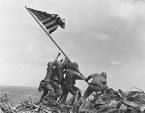
The Battle of Iwo Jima
By 1944, America and her allies in the Pacific War had the ascendancy. In the west, the Japanese were being turned back in Burma and island hopping had isolated Japanese forces in the eastern sector. Combined with the attacks on Iwo Jima, was America’s desire to finally destroy Japan’s merchant fleet so that the Japanese mainland could not be supplied from the food-rich sectors of South East Asia which Japan still had control over. Linked to this, was the destruction of Japan’s remaining industrial base by the bombing of it by the American airforce.
Iwo Jima is a very small Pacific island – just over 4.5 miles long and 2.5 miles wide which lies at the foot of the Bonin chain of islands, south of the main Japanese island of Honshu.
Despite its size, Iwo Jima was considered to have great tactical importance. There were two airfields on the island – under Japan’s control; they could be used by Japanese fighter planes to attack American bombers on their flights to Japan. Under American control, the airfields could be used as emergency landing bases for damaged airplanes in the bombing raids. They could also be used for American fighter planes to escort the bombers, as they needed smaller runways for take-off.
Knowing that the island was of such importance, the Japanese were determined to keep control of it. There were about 22,000 soldiers under the command of Lieutenant-General Kuribayashi. These men had had the time to build strong defensive positions throughout the island but especially in the north. Kuribayashi knew that his options for launching attacks were extremely limited because of the small size of the island. In fact, his options to do anything other than defend ferociously were extremely limited.
America had vast reserves at their disposal. Iwo Jima was ‘softened up’ by bombing raids for more than two months before the actual amphibious assault. For three days prior to the attack, six American battleships had launched a continuous barrage on the island. Within the region, the Americans were led by Admiral Raymond Spruance – though the overall commander of the campaign was Admiral Chester Nimitz. The landing forces were under the command of Lieutenant-General Holland ‘Howling Mad’ Smith. The bulk of the amphibious attack was done by Marines.
The first day of the landings was February 19th, 1945. The Marines took heavy casualties, as the American bombings had not been effective. What it had done was to churn up the beaches and the immediate hinterland and had given the Japanese far more opportunities to find hiding-holes for snipers. It also meant that American movement inland was hindered as the area had been so heavily bombed. A few well placed Japanese snipers could hold up an American advance for hours.
However, the Americans had cut the island in two by the end of the first day – despite taking over 2,400 casualties. On Day 2, the Marines attacked Mount Suribachi. Here they found fanatical Japanese defence and Suribachi was taken on February 23rd after three days of fighting.
Iwo Jima proved a difficult and bloody target to take – frequently the Americans only advanced at several hundred metres per day. By March 11th, the Japanese were trapped in an area around Kitano Point, the island’s most northerly extremity. By March 16th, the island was declared secure and all resistance had ceased by March 26th.
The tiny island had taken America over one month to take. The Marines lost 6,891 men killed and 18,070 wounded. Out of the 22,000 Japanese soldiers on the island, only 212 were taken prisoners. What the battle did show the Americans was how far the Japanese would go to defend their country – a decision that was to influence the use of the atomic bombs in Hiroshima and Nagasaki.




